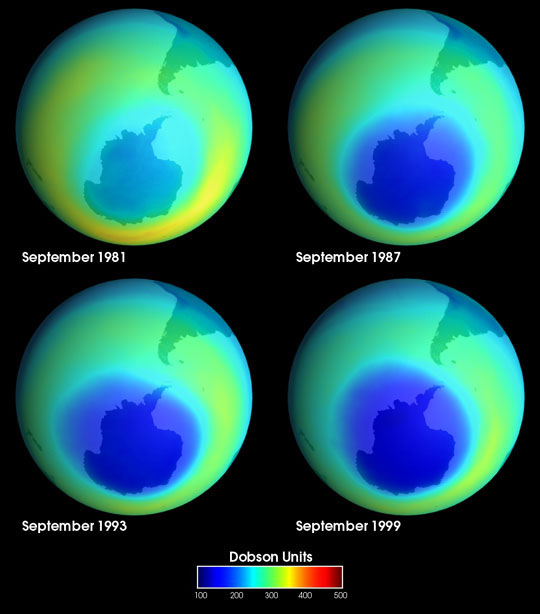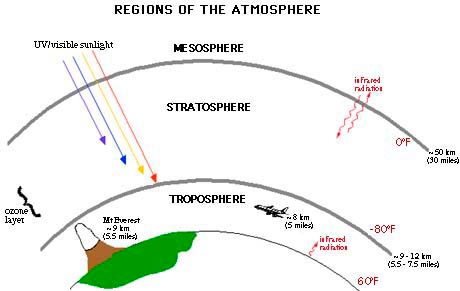7.3: Depletion of the Ozone Layer
- Page ID
- 1383
The earth's stratospheric ozone layer plays a critical role in absorbing ultraviolet radiation emitted by the sun. In the last thirty years, it has been discovered that stratospheric ozone is depleting as a result of anthropogenic pollutants. There are a number of chemical reactions that can deplete stratospheric ozone; however, some of the most significant of these involves the catalytic destruction of ozone by halogen radicals such as chlorine and bromine.
Introduction
The atmosphere of the Earth is divided into five layers. In order of closest and thickest to farthest and thinnest the layers are listed as follows: troposphere, stratosphere, mesosphere, thermosphere and exosphere. The majority of the ozone in the atmosphere resides in the stratosphere, which extends from six miles above the Earth’s surface to 31 miles. Humans rely heavily on the absorption of ultraviolet B rays by the ozone layer because UV-B radiation causes skin cancer and can lead to genetic damage. The ozone layer has historically protected the Earth from the harmful UV rays, although in recent decades this protection has diminished due to stratospheric ozone depletion.

Ozone depletion is largely a result of man-made substances. Humans have introduced gases and chemicals into the atmosphere that have rapidly depleted the ozone layer in the last century. This depletion makes humans more vulnerable to the UV-B rays which are known to cause skin cancer as well as other genetic deformities. The possibility of ozone depletion was first introduced by scientists in the late 1960's as dreams of super sonic transport began to become a reality. Scientists had long been aware that nitric oxide (NO) can catalytically react with ozone (\(O_3\)) to produce \(O_2\) molecules; however, \(NO\) molecules produced at ground level have a half life far too short to make it into the stratosphere. It was not until the advent of commercial super sonic jets (which fly in the stratosphere and at an altitude much higher then conventional jets) that the potential for \(NO\) to react with stratospheric ozone became a possibility. The threat of ozone depletion from commercial super sonic transport was so great that it is often cited as the main reason why the US federal government pulled support for its development in 1971. Fear of ozone depletion was abated until 1974 when Sherwood Rowland and Mario Molina discovered that chlorofluorocarbons could be photolyzed by high energy photons in the stratosphere. They discovered that this process could releasing chlorine radicals that would catalytically react with \(O_3\) and destroy the molecule. This process is called the Rowland-Molina theory of \(O_3\) depletion.
The Chapman Cycle
The stratosphere is in a constant cycle with oxygen molecules and their interaction with ultraviolet rays. This process is considered a cycle because of its constant conversion between different molecules of oxygen. The ozone layer is created when ultraviolet rays react with oxygen molecules (O2) to create ozone (O3) and atomic oxygen (O). This process is called the Chapman cycle.
Step 1: An oxygen molecules is photolyzed by solar radiation, creating two oxygen radicals:
\[ h\nu + O_2 \rightarrow 2O^. \nonumber \]
Step 2: Oxygen radicals then react with molecular oxygen to produce ozone:
\[O_2 + O^. \rightarrow O_3 \nonumber \]
Step 3: Ozone then reacts with an additional oxygen radical to form molecular oxygen:
\[O_3 + O^. \rightarrow 2O_2 \nonumber \]
Step 4: Ozone can also be recycled into molecular oxygen by reacting with a photon:
\[O_3 + h\nu \rightarrow O_2 + O^. \nonumber \]
It is important to keep in mind that ozone is constantly being created and destroyed by the Chapman cycle and that these reactions are natural processes, which have been taking place for millions of years. Because of this, the thickness the ozone layer at any particular time can vary greatly. It is also important to know that O2 is constantly being introduced into the atmosphere through photosynthesis, so the ozone layer has the capability of regenerating itself.
Chemistry of Ozone Depletion
CFC molecules are made up of chlorine, fluorine and carbon atoms and are extremely stable. This extreme stability allows CFC's to slowly make their way into the stratosphere (most molecules decompose before they can cross into the stratosphere from the troposphere). This prolonged life in the atmosphere allows them to reach great altitudes where photons are more energetic. When the CFC's come into contact with these high energy photons, their individual components are freed from the whole. The following reaction displays how Cl atoms have an ozone destroying cycle:
\[Cl + O_3 \rightarrow ClO + O_2 \tag{step 1} \]
\[ClO + O^. \rightarrow Cl + O_2 \tag{step 2} \]
\[O_3 + O^. \rightarrow 2O_2 \tag{Overall reaction} \]
Chlorine is able to destroy so much of the ozone because it acts as a catalyst. Chlorine initiates the breakdown of ozone and combines with a freed oxygen to create two oxygen molecules. After each reaction, chlorine begins the destructive cycle again with another ozone molecule. One chlorine atom can thereby destroy thousands of ozone molecules. Because ozone molecules are being broken down they are unable to absorb any ultraviolet light so we experience more intense UV radiation at the earths surface.

From 1985 to 1988, researchers studying atmospheric properties over the south pole continually noticed significantly reduced concentrations of ozone directly over the continent of Antarctica. For three years it was assumed that the ozone data was incorrect and was due to some type of instrument malfunction. In 1988, researchers finally realized their error and concluded that an enormous hole in the ozone layer had indeed developed over Antarctica. Examination of NASA satellite data later showed that the hole had begun to develop in the mid 1970's.
The ozone hole over Antarctica is formed by a slew of unique atmospheric conditions over the continent that combine to create an ideal environment for ozone destruction.
- Because Antarctica is surrounded by water, winds over the continent blow in a unique clockwise direction creating a so called "polar vortex" that effectively contains a single static air mass over the continent. As a result, air over Antarctica does not mix with air in the rest of the earth's atmosphere.
- Antarctica has the coldest winter temperatures on earth, often reaching -110 F. These chilling temperatures result in the formation of polar stratospheric clouds (PSC's) which are a conglomeration of frozen H2O and HNO3. Due to their extremely cold temperatures, PSC's form an electrostatic attraction with CFC molecules as well as other halogenated compounds
As spring comes to Antarctica, the PSC's melt in the stratosphere and release all of the halogenated compounds that were previously absorbed to the cloud. In the antarctic summer, high energy photons are able to photolyze the halogenated compounds, freeing halogen radicals that then catalytically destroy O3. Because Antarctica is constantly surrounded by a polar vortex, radical halogens are not able to be diluted over the entire globe. The ozone hole develops as result of this process.
Resent research suggests that the strength of the polar vortex from any given year is directly correlated to the size of the ozone hole. In years with a strong polar vortex, the ozone hole is seen to expand in diameter, whereas in years with a weaker polar vortex, the ozone hole is noted to shrink
Ozone Depleting Substances
The following substances are listed as ozone depleting substances under Title VI of the United State Clean Air Act:
| Substance | Ozone- depletion potential |
|---|---|
| chlorofluorocarbon-11 (CFC–11) | 1.0 |
| chlorofluorocarbon-12 (CFC–12) | 1.0 |
| chlorofluorocarbon-13 (CFC–13) | 1.0 |
| chlorofluorocarbon-111 (CFC–111) | 1.0 |
| chlorofluorocarbon-112 (CFC–112) | 1.0 |
| chlorofluorocarbon-113 (CFC–113) | 0.8 |
| chlorofluorocarbon-114 (CFC–114) | 1.0 |
| chlorofluorocarbon-115 (CFC–115) | 0.6 |
| chlorofluorocarbon-211 (CFC–211) | 1.0 |
| chlorofluorocarbon-212 (CFC–212) | 1.0 |
| chlorofluorocarbon-213 (CFC–213) | 1.0 |
| chlorofluorocarbon-214 (CFC–214) | 1.0 |
| chlorofluorocarbon-215 (CFC–215) | 1.0 |
| chlorofluorocarbon-216 (CFC–216) | 1.0 |
| chlorofluorocarbon-217 (CFC–217) | 1.0 |
| halon-1211 | 3.0 |
| halon-1301 | 10.0 |
| halon-2402 | 6.0 |
| carbon tetrachloride | 1.1 |
| methyl chloroform | 0.1 |
| hydrochlorofluorocarbon-22 (HCFC–22) | 0.05 |
| hydrochlorofluorocarbon-123 (HCFC–123) | 0.02 |
| hydrochlorofluorocarbon-124 (HCFC–124) | 0.02 |
| hydrochlorofluorocarbon-141(b) (HCFC–141(b)) | 0.1 |
| hydrochlorofluorocarbon-142(b) (HCFC–142(b)) | 0.06 |
References
- Dessler, Andrew. The Chemistry and Physics of Stratospheric Ozone. San Diego, Ca: Academic Press, 2000
- Hoffman, Matthew J. Ozone Depletion and Climate Change. Albany, NY: State University of New York Press, 2005
- Parson, Edward A. Protecting the Ozone Layer: Science and Strategy. New York: Oxford University Press, 2003.
- Petrucci, Ralph H., William S. Harwood, and Geoff E. Herring. General Chemistry : Principles and Modern Applications. 9th ed. Upper Saddle River: Prentice Hall, 2006.
- Varotsos, Costas, Kirill Ya. Kondratyev. Atmospheric Ozone Variability: Implications for Climate Change, Human Health and Ecosystems. Chichester, UK: Praxis Publishing Ltd, 2000
- Godish, Thad. Air Quality. 4th ed. Florida: CRC Press LLC, 2004.
- United States Clean Air Act: as of June 3rd, 2010.
General Questions
- What are the causes of the depletion of our ozone layer?
- the release of free radicals, the use of CFC's, the excessive burning of fossil fuels
- What is the chemical reaction that displays how ozone is created?
- UV + O2 -> 2O + heat, O2 + O -> O3, O3 + O -> 2O2
- Which reactions demonstrate the destruction of the ozone layer?
- Cl + O3 ------> ClO + O2 and ClO + O ------> Cl + O
- How do CFC's destroy the ozone layer?
- the atomic chlorine freed from CFC reacts in a catalytic manner with ozone and atomic oxygen to make more oxygen molecules
- Why should regulations be enforced now in regards to pollution and harmful chemicals?
- without regulation, the production and use of chemicals will run out of hand and do irreversible damage to the stratosphere
- What type of atom in the CFC molecule is most destructive to the ozone?
- chlorine
- In which layer of the atmosphere does the ozone layer?
- the stratosphere, the second closest to the Earth's surface
- What cycle is responsible for ozone in the stratosphere?
- the Chapman cycle
- What factor is responsible for breaking up stable molecules?
- ultraviolet rays from the sun

